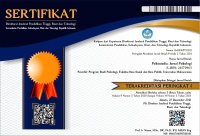Behavior Modification Intervention with Antecedent Control Technique to Improve Toilet Training in Toilet-Resistant Children
Abstract
Toilet training represents a crucial yet challenging stage in a child's development of independence (Setiawati & Putriana, 2019). Therefore, intervention becomes essential when a child encounters obstacles in completing toilet training, particularly when the child exhibits significant resistance to using the toilet. This study aims to enhance urination behavior in children resistant to toilet training (e.g., exhibiting tantrums when prompted to use the toilet) and experiencing setbacks in the toilet training process. The research employed a single-subject A-B with follow-up design, involving a sole participant (N=1). The intervention techniques utilized included antecedent control procedures and reinforcement, packaged in the form of games tailored to the child's interests. The intervention spanned 24 days, comprising 3 days for baseline assessment and measurement sessions, 14 days for intervention sessions, and 7 days for follow-up sessions. The study's findings reveal an increase in the frequency of children urinating in the toilet without refusal or tantrums, achieved through behavior modification interventions utilizing antecedent control procedures.
Toilet training merupakan tahapan penting sekaligus menantang bagi perkembangan kemandirian anak (Setiawati & Putriana, 2019). Oleh sebab itu, intervensi sangat dibutuhkan jika anak memiliki hambatan dalam menyelesaikan toilet training, khususnya jika anak cukup resisten untuk diajak ke toilet. Penelitian ini bertujuan untuk meningkatkan perilaku buang air kecil di toilet pada anak yang resisten (misalnya, selalu tantrum saat diajak ke toilet) dan mengalami kemunduran dalam proses toilet training. Penelitian ini menggunakan desain penelitian single subject A-B with follow-up design, yaitu hanya melibatkan satu partisipan (N=1). Teknik intervensi yang digunakan adalah teknik antecedent control procedure dan reinforcement yang dikemas dalam bentuk permainan yang disesuaikan dengan minat anak. Intervensi berlangsung selama 24 hari, yaitu 3 hari untuk sesi asesmen dan pengukuran baseline, 14 hari untuk sesi intervensi, dan 7 hari untuk sesi follow up. Hasil penelitian menunjukkan bahwa adanya peningkatan frekuensi anak untuk buang air kecil di toilet tanpa disertai dengan penolakan dan juga tantrum melalui intervensi modifikasi perilaku dengan teknik antecedent control procedure.
Keywords
Full Text:
FULL TEXTReferences
American Academy of Pediatrics. (2016). The american academy of pediatrics guide to toilet training: revised and updated second edition. US: Bantam.
Annisa, N., & Tedjasaputra, M. S. (2020). Penerapan teknik antecedent control untuk meningkatkan toilet training pada anak dengan masalah konstipasi. Jurnal Ilmiah Psikologi Terapan, 8(1), 75-84. https://doi.org/10.22219/jipt.v8i1.10182.
Baird, D. C., Bybel, M., & Kowalski, A. W. (2019). Toilet training: common questions and answers. American family physician, 100(8), 468-474.
Blum, N. J., Taubman, B., & Nemeth, N. (2003). Relationship between age at initiation of toilet training and duration of training: a prospective study. Pediatrics, 111(4), 810-814.
Choby, B. A., & George, S. (2008). Toilet training. American Family Physician, 78(9), 1059-1064.
de Carvalho Mrad, F. C., da Silva, M. E., Lima, E. M., Bessa, A. L., de Bessa Junior, J., Netto, J. M. B., & de Almeida Vasconcelos, M. M. (2021). Toilet training methods in children with normal neuropsychomotor development: A systematic review. Journal of Pediatric Urology, 17(5), 635-643.
Faz, G. O. (2015). Penerapan metode modifikasi perilaku pembentukan (shaping) untuk membentuk perilaku sosial anak dengan ketidak-mampuan intelektual ringan. Jurnal Psikologi Tabularasa, 10(2).
Hapsari, C. K., & Hartiani, F. (2018). Penerapan prinsip modifikasi perilaku untuk meningkatkan kemampuan menyikat gigi pada anak dengan disabilitas intelektual berat. Jurnal Psikologi, 17(2), 119-130.
Hutomo, L., & Wulandari, P. Y. (2023). Improving the ability to wear socks in autistic children through behavior modification Interventions. Psikostudia: Jurnal Psikologi, 12(1), 79-86.
Miller, P.H. (2016). Theories of developmental psychology (6th ed). New York: Worth Publisher.
Miltenberger, R.G. (2016). Behavior modification principles and procedures (6thed.). USA: Cengage Learning.
Mota, D. M., & Barros, A. J. D. (2008). Toilet training: Methods, parental expectations and associated dysfunctions. Journal of Pediatrics, 64(1), 9–17. https://doi.org/10.2223/JPED.1752.
Nasution, E. S. (2016). Efektifitas modifikasi perilaku untuk mengatasi enuresis pada anak. Jurnal Psikologi Pendidikan Dan Pengembangan Sdm, 4(1).
Netto, M. B., Paula, J. C. D., Bastos, C. R., Soares, D. G., Castro, N. C. T. D., Sousa, K. K. D. V., ... & Bessa Jr, J. D. (2020). Personal and familial factors associated with toilet training. International braz j urol, 47, 169-177.
Pierotti, N. (2010). Night toilet training step by step. Townsville Bulletin (Townsville, Qld.).
Pujiati, N. I., & Dahlan, T. H. (2017). Modifikasi perilaku melalui teknik token economy untuk meningkatkan perilaku tanggung jawab anak usia dini. Journal of Innovative Counseling: Theory, Practice, and Research, 1(02), 10-22.
Rachmah, A., Santi, E., & Rachmawati, K. (2019). Peran orang tua dengan keberhasilan toilet training anak usia toddler. Nerspedia, 1(1), 75-82.
Simbolon, P. F., & Ardisal, A. (2020). Meningkatkan kemampuan toilet training pada anak autis melalui total task presentation. Journal of Basic Education Studies, 3(2), 878-887.
Setiawati, D. N. A. E., & Putriana, D. (2019). Mother perception of toilet training in toddler. In 4th ASEAN Conference on Psychology, Counselling, and Humanities (ACPCH 2018) (pp. 95-98). Atlantis Press.
Schonwald, A., Sherritt, L., Stadtler, A., & Bridgemohan, C. (2004). Factors Associated With Difficult Toilet Training. Pediatrics, 113(6), 1753–1757. doi:10.1542/peds.113.6.1753
Susanty, W.T., Munir, Z., & Kholisotin, K. (2021). Metode modeling dalam keberhasilan toilet training pada anak. Jurnal Media Keperawatan: Politeknik Kesehatan Makassar, 12(1), 149-160.
Utami, A. R., & Tedjasaputra, M. S. (2018). Penerapan teknik total task presentation untuk meningkatkan keterampilan buang air kecil pada anak dengan disabilitas intelektual moderat. Jurnal Psikologi, 7(2), 161-173.
Van Aggelpoel, T., De Wachter, S., Van Hal, G., Van der Cruyssen, K., Neels, H., & Vermandel, A. (2022). Parents’ views on toilet training: a cross-sectional study in Flanders. Nursing children and young people, 34(4).
Warlenda, S. V., & Sari, R. N. (2017). Pengetahuan ibu berhubungan dengan Pelaksanaan toilet training pada Anak Usia 3-5 Tahun di PAUD Islam Cerliana Kota Pekanbaru Tahun 2016. Jurnal Kesehatan Komunitas, 3(3), 105-109.
Wyndaele, J. J., Kaerts, N., Wyndaele, M., & Vermandel, A. (2020). Development signs in healthy toddlers in different stages of toilet training: can they help define readiness and probability of success?. Global Pediatric Health, 7, 2333794X20951086
DOI: http://dx.doi.org/10.30872/psikostudia.v12i3.12018
Refbacks
- There are currently no refbacks.
Copyright (c) 2023 Psikostudia : Jurnal Psikologi

This work is licensed under a Creative Commons Attribution-ShareAlike 4.0 International License.
Psikostudia: Jurnal Psikologi is indexed by :
PSIKOSTUDIA: Jurnal Psikologi Published by Faculty of Social and Political Siences, University of Mulawarman, Samarinda, East Kalimantan and This work is licensed under a Creative Commons Attribution-ShareAlike 4.0 International License.
_________________________________________
PSIKOSTUDIA: Jurnal Psikologi
Department of Psychology
Faculty of Social and Political Siences, University of Mulawarman
Jl. Muara Muntai Kampus Gn. Kelua Samarinda 75411
Phone: +62 813 35350368
E-Mail: psikostudia@fisip.unmul.ac.id




















